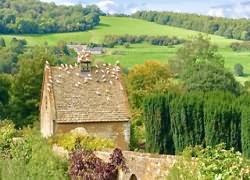Also see second article by Russ Firlik - More to the Cotswolds....
There is more to the Cotswolds than Rolling Hills and Grazing Sheep: Searching for 5,000 Years of History and Architecture in the Cotswolds by visiting Americans from Florida Russ Firlik and pictures by Emily Firlik.
Many years ago we lived in Oxfordshire, England, and our daughter was born in a little village near Oxford. This year we revisited our old stamping grounds in and around Oxfordshire, as well as the rest of the Cotswolds region in England.
The Cotswolds have a very Beatrix Potter feel - No, they are not located in the Lake District, and you will not find Jemima puddle duck, Squirrel Nutkin, nor Peter. However, you will find hedgerows, Ha Ha's, stiles and thorps that are reminiscent of her region. Pastoral villages with names like Burford, Chipping Norton, Morton in the Marsh and Great Rissington does this storybook land of 800 square miles.
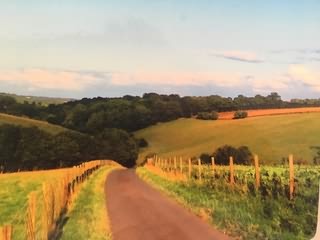
"Beatrix Potter feel" of the Cotswolds
Buried among the warm golden-honey bedrock of Jurassic limestone are those massive areas of rolling hills, and sheep grazing in the meadows. It is the home of the most unspoilt historic and famous towns and villages in England. It is here that our search began, and discovered five thousand years of history and architecture within this fascinating central region of England that runs southwest to northeast through six
counties.
The Cotswolds Tourist annual Economic Impact Study of 2018 indicated that over one million people visited the Cotswolds, that generated about 1 billion British Pounds in 2017. The Cotswolds are a vast 800 square miles that include the counties of Oxfordshire , Gloucestershire, Somerset, Warwickshire, Worcestershire, and the corners of Wiltshire. This 25 mile wide, and 102 mile long - six counties boundaries - makes up this beautiful area the Cotswolds.
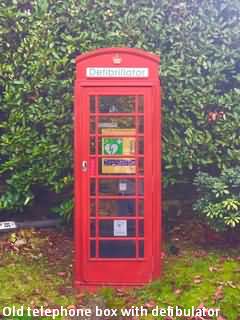 What really brought us back to revisit Oxfordshire and the Cotswolds was to explore the historical and architectural treasures that lie within this region. Most visitors to the Cotswolds no doubt are fascinated by and overwhelmed with the many pretty villages and sheep grazing on the rolling hills that surely dominate this region. But there is more to the Cotswolds than pretty villages and sheep grazing on those rolling hills. Our three months search in the Cotswolds located over 5,000 years of history and architectural styles. What really brought us back to revisit Oxfordshire and the Cotswolds was to explore the historical and architectural treasures that lie within this region. Most visitors to the Cotswolds no doubt are fascinated by and overwhelmed with the many pretty villages and sheep grazing on the rolling hills that surely dominate this region. But there is more to the Cotswolds than pretty villages and sheep grazing on those rolling hills. Our three months search in the Cotswolds located over 5,000 years of history and architectural styles.
"There is something delicious about writing the first words of a story. You never quite know where they'll take you." (1). B. Potter
Getting Started
The first task was to hire a small vehicle, and take our time to learn to drive on the left side of the road. After a week of driving on single lanes and "B" roads, the driving experience in the Cotswolds became less of a chore and more of a road trip adventure.
For the remaining three months, and driving over 4,500 miles, we located what we were searching, that is, 5,000 years of history and architecture in the Cotswolds.
Notes: (1). The dates for these periods/styles are somewhat flexible, in that a few years
either way are acceptable to the professionals, (2). We have tried to identify major
noticeable features or characteristics of each particular periods as we searched for the
locations of the churches, structures, and buildings of each period or style.
The historical and architectural search began with the oldest, the Neolithic, around
4,300 - 2,000 BCE. There are only a few ruins from this period in the Cotswolds. The
Roll Right Stones (2,500 BCE) the Notgrove Long Barrow (3,500 BCE) and Belas Knap
Long Barrow (4,300 BCE) are the ancestral burial sites we located and photographed.
Further research assisted in a more deeper understanding these ancient sites.
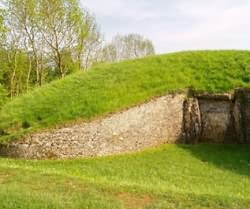
Belas Knap Long Barrow 4300 BC |
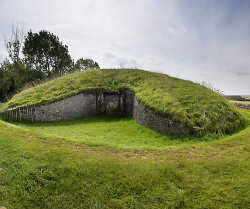
Belas Knap Long Barrow |
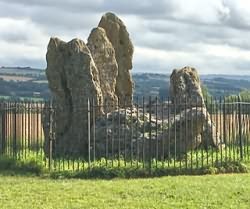
Kings Men Stones 2500 BC |
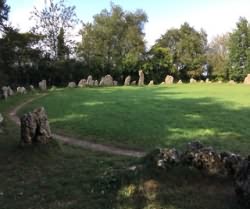
Roll Right Stones 2500 BC |
Moving from the oldest Neolithic period, to the Anglo-Roman settlements from the first
through the fifth centuries AC. Today, the most famous and most visited Roman site in
South West England are the Roman Baths, in Bath, constructed around 70 AC. Two
other Roman ruins were located at North Leigh Roman Villa (180-350 AC) and
Chedworth Roman Villa. The English National Trust does a wonderful job in posting bits
of history and sometimes reproductions of what these historical sites might have looked
like during that ancient period.
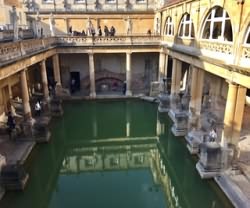
Roman Baths 70 AD |
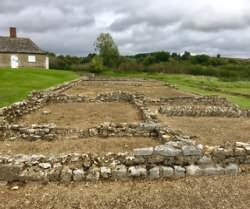
Roman Villa at North Leigh - 100 AD to 500 AD |
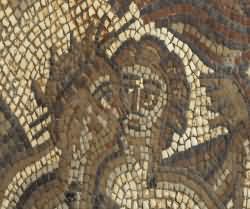
Chedworth Roman Villa - Mosaic Floor |
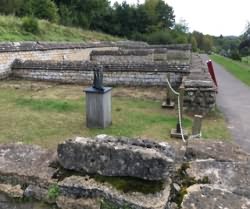
Chedworth Roman Villa - 180 AD to 355 AD |
These two periods, the Neolithic and Anglo-Roman periods, were the easiest to locate
and that is why we chose to find them at the very beginning of our journey. The next,
roughly sixteen periods, is where our extensive research and, maturing-driving skills,
really took hold in our pursuit to explore, in detail, the treasures of the Cotswolds.
The Anglo-Saxon Period from 600 - 1,066 AC. During this period the system of
construction came from two sources:
(1). The Greek column and beam system, and
(2) Arch and the vault. An important technical innovation was the use of concrete, which
made Roman architecture massive and heavy.
Since the Cotswolds were one of the provinces further from Rome, the buildings were
smaller and less grand than those buildings in Rome.
Examples of this period included the Saxon church of St. George in village of Coln
Rogers and St. Nicholas and All Angels Church in Winson, which used stone and
timber. Their doorways were narrow and without mouldings. The windows in Saxon times
were narrow with stonework around the windows. These churches' windows were either
semicircular or triangular, typical of this period.
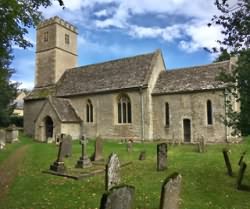
St George's Church - Colne Rogers
Saxon 600 to 1066
|
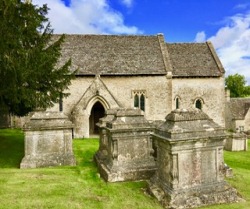
St Nicholas and All Angels Church - Winson
Saxon 600 to 1066 |
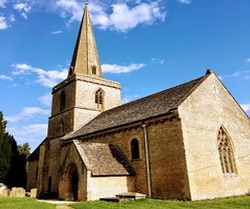
St Peter's Church at Cassington
Romanesque - Norman 1066 to 1190 |
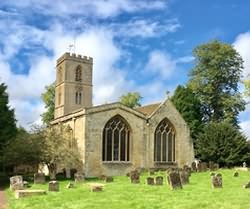
St Mary the Virgin Church at Charlbury
Gothic 1190-1290 |
These old churches prey to your senses: the smell of old stone and timber, the sight of
800 year old stone as they were, touching the detailed stone carvings, and the sound of
silence that resonates within these old Saxon churches.
Although these findings are written in ascending order (oldest to newest), we did not
accomplish our results in this particular order. They were placed in order for easier
reading.
The period from 1,066 to 1,190, or Anglo-Norman architecture was superior to the
Anglo-Saxon architecture. This period was the transition to Gothic style.
The Norman church of St. Peter in Cassington and St. Mary the Virgin Church at
Charlbury showed the beginning of the highly ornamented stone carvings, capitals
highly decorative with carved figures or foliage, mouldings to the width of the door
openings, and heavy recessed western entryways.
It was the first time seeing a groin vault - cross ribs making an "X" shape within each
bay. These findings were visibly more decorative than those found in the Anglo-Saxon
churches.
Gothic architecture, 1,190 to 1,485, dominated architecture for the next 300 years.
Gothic architecture in England is divided into three distinct periods:
(1). Early English -1,190. To 1,290;
(2). Decorative - 1,290 - 1,375; and,
(3). Perpendicular - 1,375 - 1,485.
The obvious Early English characteristics found in St. Mary church in Witney and in
Asthall's, the Church of St. Nicholas, included pointed arches, which made it possible for the construction of the rectangular high rib vaults seen for the first time during our
visits.
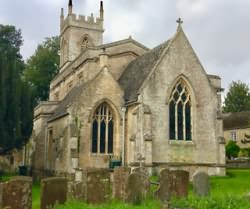
St Nicholas Church - Chadlington
Gothic Early English - 1190 to 1290
|
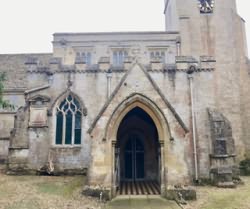
Church of St Mary - Taynton
Gothic / Decorated 1190-1375 |
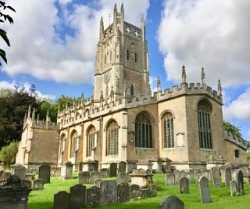
St Mary's Church at Fairford
Gothic / Perpendicular 1190 - 1485 |
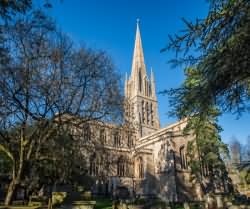
St Mary's Church at Witney
Dates back to 12th Century
|
Other characteristics observed in these churches included our first sighting of flying
buttresses, and taller windows with tracery, an essential feature of this Gothic period.
The tracery is stonework that supports the large glass windows.
In Bloxham and Taynton, we found the best examples of the Gothic Decorated Period
(1,290-1,375) in the Cotswolds. There were key indicators of this period at St. Mary's
church and St. John the Baptist. This is the time in which Gothic style reached its
maturity in England. The arches were equilateral and symmetrical. The windows were
enlarged and divided by mullions and tracery much more dedicated. What surprised us
was the new effects of light and shade, a celebrity of the variety of windows in these
churches. First time sighting were stained glass, tile work and playful themes on the
capitals.
Whereas the columns in the Early English period were plain and cylindrical, these
Decorated columns, or pillars, had clustered shafts, and the capitals where circular with
foliage in natural form. St. Mary's church had curvilinear windows with the "ogee" or "S"
curves - Brilliant!
The Perpendicular style 1,350–1,485, was a marked contrast to the Decorated. Curves
were replaced with straight lines with repetitive, sober masculine lines. This
Perpendicular style was the last phase of Gothic, a kind of national Medieval style of
squareness: windows more uniform, wider and more expansive, mullioned windows,
centred arches and wide arcades and a variety of vaulting types were best illustrated
in these three magnificent church structures found in Adderbury, Minster Lovell and
Burford.
The Tudor style - 1,485-1,558, was one of the most exciting and interesting period for
us as it was the tentative introduction of Renaissance architecture in England. The
four-centered Tudor arch, a defining feature observed, and the remarkable oriel or bay
window a centrepiece of this period. Tudor style was the final development of Medieval
architecture in England. Most everyone recognizes the lavish half-timbered building in
Stratford upon Avon. Technically, Stratford upon Avon is not in the designated region of the Cotswolds.
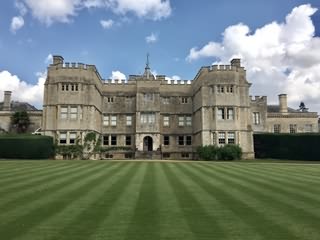
TUDOR : 1485-1558 - ROUSHAM HOUSE, ROUSHAM PARK
We located several Tudor buildings in and around Oxfordshire: The Upton House in
Banbury, Broughton Castle, the Rousham House and the Tolsey Museum In Burford.
The Tudor style seemed to retained its hold on English tastes.
Renaissance England- 1,558-1,702. Three historical phases and dates mark this
Renaissance period in England.
Elizabethan - 1,558 - 1,603, corresponding to the reign of Queen Elizabeth, and what
historians depict it as the "golden age" of English history.
Second phase, The Jacobean, named after King James I.
Third phase, The Stuart, heavily influenced by German and Flemish Baroque. This
particular searching journey entailed endless driving on single lane roads and "B" roads,
or second-class or minor roads connecting villages or town streets. However, the
topography and landscapes during these drives were amazing: passing pretty villages
and sheep grazing on rolling hills.
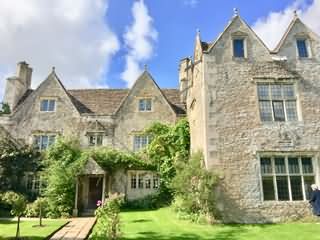
RENAISSANCE: 1558-1702 - KELMSCOTT MANOR IN KELMSCOTT
As we move further into the architectural styles from the Gothic (1,190-1,485) churches
we discovered Renaissance buildings and Manor Houses in such places as Sherborne,
Sherborne House, in Kelmscott Manor and the Westonbirt House in Tetbury in the
Western Cotswolds. The common characteristics among these structures were the
influences of Italian Renaissance and Dutch: Curved gables, open courtyards, clustered
in groups of 2 or 3 chimney stacks reflecting Italian Renaissance influence. Striking
internal features included decorative ribbon-like strapwork, coloured marble, and the
most ostentatious main entrances.
The most difficult findings that represented the Renaissance's second phase was the
Jacobean. We located The Dial House in Bourton-on-the- Water, Wroxton Abbey, Bibury
Court, The Chastleton House in Chastleton, and finally the house number 20, in our
favourite town of Woodstock.
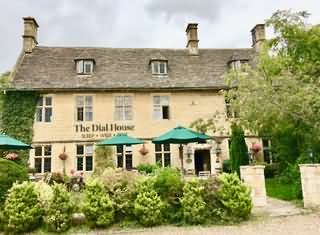
JACOBEAN: 1603 - 1635 : BOURTON-ON-THE WATER AND THE DIAL HOUSE
General characteristics included the remains of the Elizabethan design, more use of
columns and pilasters, flat roofs, open parapets and Classical elements in a free and
fanciful manner.
If we thought locating the second phase of Renaissance style was difficult, now we
approach the third phase called Stuart 1,625-1,702. Although there are fewer examples
of Stuart era examples in the Cotswolds, we enjoyed spending time in Chipping Norton to view the Almshouses -1,640, the fascinating village of Bibury, and a tasty pub lunch
at the Stuart dated Swan Inn. We returned to Woodstock to view houses 16-20, on
Market Street.
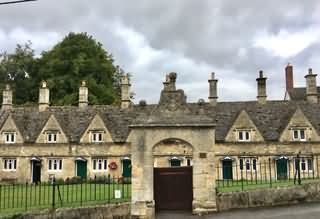
STUART : 1635-1702 - TOWN OF CHIPPING NORTON AND THE ALMSHOUSES
Some unique characteristics of this period included rows of identical windows, symmetrical facades, tall chimneys, beautiful brickwork, classical proportions, and the use of vernacular building materials that are local to the area.
The Renaissance period ended with the Stuart style, and the beginning of a brand new
style of architecture emerged, that being the English Baroque - 1,695 - 1,725. Of course, the most recognized example of English Baroque style is Blenheim Palace in Woodstock. The Methodist Chapel Church in Burford and St. Peter's church in Filkins
are very representative of the Baroque style in the Cotswolds.
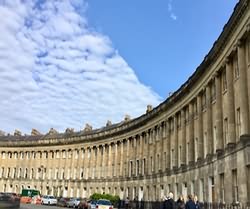
GEORGIAN: 1702-1837 - BATH'S ROYAL CRESCENT |
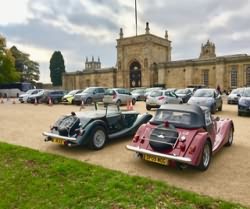
BAROQUE : 1695-1725 - BLENHEIM PALACE |
Baroque in England utilized bold masses of curved shapes, clustered chimneys, strong
lines with symmetrical wings on the sides and rich colours of the local materials mainly
brick and stone. However, English Baroque had a conservative appearance giving a
weaker sense of movement and less dynamic compared to other European Baroque
constructions.
Broadway, the Broadway Tower, the Dover's House in Chipping Campden, the Town Hall in Woodstock, and the 30 terraced houses laid out in the Royal Crescent, and the
three curved crescents of The Circus in Bath represented the next architectural phase:
Georgian - 1,702 - 1,837. Characteristics we observed that represented the Georgian
style included the use of brick to disguised with stucco, ashlar blocks stone, balconies,
ornamentation in a classical tradition, and a balanced style marked by symmetry and
proportions based on classical architecture of Greece and Rome.
The Palladian phase of Cotswold architecture: 1,720 - 1,760, was based on the
philosophy of design based on the writings and work of Andreas Palladio, an Italian
architect on the 16th century. His goal was to try to recreate the style and proportions of
the buildings of Ancient Rome. This phase did not last long in England, but the
Palladian examples in the Cotswolds were excellent: Barrington Park, the Harrington
House in Bourton-on-the-Water and the Fairford House in Fairford for example.
What characterizes English Palladian architecture? Refined elegance, understated
decorative elements, attention to architectural elements of Ancient Rome, and the use
of classical orders. Probably the most attractive style we have witnessed during our
journey.
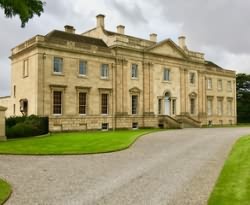
PALLADIUM 1720 to 1760 Barrington Park |
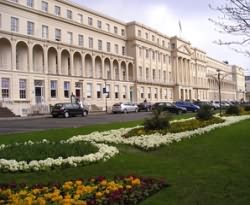
REGENCY 1810 TO 1834 Cheltenham Promenade |
Another architectural- historical phase that only lasted 20 odd years, was the Regency:
1,810-1,837. In many respects it is a natural continuation of the previous Georgian style.
This period experienced a great surge of interest in classical Greece. Windows are tall
and thin, balconies with extremely fine ironwork, classical lines, brick covered with
stucco, fluted Greek columns, refined elegance, and finally, row houses or terrace
houses. Exemplary examples of the Regency style were found in the well known town of
Cheltenham, including the Terrace House, Pittville Pump Room and Holst Museum.
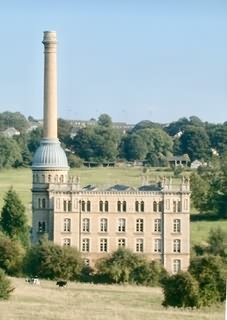 Victorian: and Queen Victoria - 1,837- 1,901 and Edwardian 1,901 - 1,910 - King Edward VII. To differentiate between the two compatible styles is rather difficult to determine. We were told by the Victorian: and Queen Victoria - 1,837- 1,901 and Edwardian 1,901 - 1,910 - King Edward VII. To differentiate between the two compatible styles is rather difficult to determine. We were told by the
Chipping Norton Historical Society that as a rough rule of thumb, that the Edwardian housing tends to be slightly squatter than Victorian, but other features are often similar; however, this bit of advice really did not help us. Finding locations that represented either Victorian and Edwardian style was rather difficult, but with the assistance from the director of the Chipping Norton Museum, we were able to locate several in and about the Cotswolds. Chipping Norton gave us the Town Hall, and Bliss Mill, Lower Slaughter provided us the Village Hall, Great Barrington and the Beaufort Hunt. In addition, Asthall Manor, the Batsford House in Batsford, and the Cheltenham Town Hall.
Most of these characteristics were found in all these buildings in the Cotswolds: patterned bricks with alternating headers, houses with terraces and gardens in the front
and rear. The Edwardian chimneys of the Batsford House were sloped down directly
above the fireplace. Finally, Edwardian houses tend to be tall and thin, as we
experienced, along winding lanes and cul-de-sac. Note: Sign postings of villages and
hamlets were only "suggestions" in terms of where the actual village or hamlet were
located; made driving and finding that much more of a joy-ride.
This brings us to the Arts and Crafts Movement from 1,880 - 1,920's. English reformer,
poet, painter and designer, William Morris, founded a firm of interior decorators and
manufactures dedicated to recapturing the spirit and quality of medieval craftsmanship.
Due to Morris' efforts, he widened the appeal of the Arts and Crafts Movement to a new
generation. Fortunately, this period produced many examples in the Cotswolds. The
features included: building with natural materials, wood, stone and brick, porches with
stone porch supports, low-pitched gabled roofs with wide eaves, exposed beams, open
floor plan, that were the symbol of family in the Arts and Crafts movement.
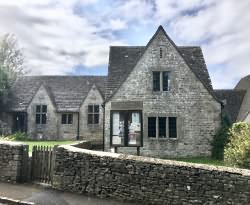
Arts & Crafts 1880 to 1920
Village of Sapperton & Village Hall |
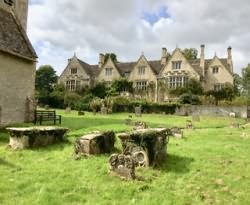
Edwardian 1901 to 1910
Village of Asthall and Manor House |

ARTS & CRAFTS - Rodmarton Manor and village houses
Fortunately, there were many, many fine examples of the Arts and Crafts structures in
the Cotswolds. These locations were in Rodmarton Manor, the Village Hall in
Sapperton, the Court Barn Museum in Chipping Campden, the Tudor Hall in Owlpen,
Painswick Lodge, the Holcomb's House and Gyle Almshouses in Painswick.
Finally, William Morris's manor house retreat in the Cotswold village of Kelmscott, is not
of the Arts and Craft variety, but is a stunning 16th century manor house, and is on the
National Heritage List for England.
Conclusions
I. Many of the initial dates of these churches, buildings and barns have been
altered, added-on-to, and transitioned to the next period of architectural tastes.
However, we tried to stay as close as possible to the initial date of the churches,
buildings and barns.
II. We found some contradictions in the many resources we used with respect to
dates of sites in question. When there were obvious date conflict (only a few)
between book or article authors, we made personal inquiries from the local
museums and tourist boards; they proved to be very helpful in authorizing dates.
III. On journey took three months, visiting over 60 villages, towns, hamlets and
cities, and 4,500 drive miles within the Cotswolds region.
IV. We were overjoyed to find more than one example of each period, and in most
cases we found several examples. Churches, buildings, ancient ruins and barns
were recorded and photographed.
V. Some of the finest traditional barns are located in the Cotswolds. The tithe
barn in Middle Littleton is particularly well preserved, and dates to the 13th
century.
VI. The 5,000 years of Historical/Architectural dates ranged from 4,300 BCE to
1,920 AD
VII. We found more Romanesque - Norman churches and structures than any other
period.
VIII. More Perpendicular Gothic churches than Early English or Decorated.
IX. More Tudor sites than Elizabethan.
X. More Jacobean than Stuart.
XI. More Georgian than Palladian.
XII. More Victorian than Regency or Edwardian.
XIII. After exploring over 60 villages, towns, hamlets and cities in the Cotswolds, we
learned about the history and architecture that is just waiting to be discovered.
Hopefully, this article will be an incentive for senior citizens, baby boomers,
"slow-travellers", and anyone who might have a curious sense of history, and a
keen interest in the beauty of the architectural periods. All of these inspirations
are smack in the Cotswolds region of England.
One final " Thank You" to the many people in the six counties of the Cotswolds for their
assistance, guidance and patience. We could not have accomplished this joyful journey
without the help of the collective "towns' libraries, tourist centres, museum directors, and
in many instances, local history and architecture experts who were most willing to assist
us. Thank you also to the Cotswolds Tourist Information Site, the Oxfordshire
Heritage Guide, Cotswolds District Council, Cotswolds Visitor Guide, and the British
National Trust.
"With Opportunity the World is Very Interesting" (2). B.Potter
Emily and Russ Firlik are retired educators. They continue to be active learners as
"slow travellers." Instead of just passing through, they make the time to uncover the
treasures that are in abundance throughout this world.
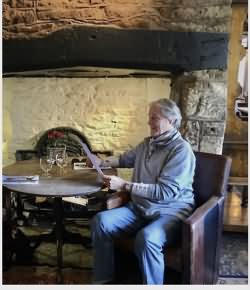
Russell Firlik in a Cotswold Inn |
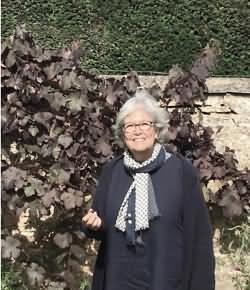
Emily Firlik |
|




 What really brought us back to revisit Oxfordshire and the Cotswolds was to explore the historical and architectural treasures that lie within this region. Most visitors to the Cotswolds no doubt are fascinated by and overwhelmed with the many pretty villages and sheep grazing on the rolling hills that surely dominate this region. But there is more to the Cotswolds than pretty villages and sheep grazing on those rolling hills. Our three months search in the Cotswolds located over 5,000 years of history and architectural styles.
What really brought us back to revisit Oxfordshire and the Cotswolds was to explore the historical and architectural treasures that lie within this region. Most visitors to the Cotswolds no doubt are fascinated by and overwhelmed with the many pretty villages and sheep grazing on the rolling hills that surely dominate this region. But there is more to the Cotswolds than pretty villages and sheep grazing on those rolling hills. Our three months search in the Cotswolds located over 5,000 years of history and architectural styles.























 Victorian: and Queen Victoria - 1,837- 1,901 and Edwardian 1,901 - 1,910 - King Edward VII. To differentiate between the two compatible styles is rather difficult to determine. We were told by the
Victorian: and Queen Victoria - 1,837- 1,901 and Edwardian 1,901 - 1,910 - King Edward VII. To differentiate between the two compatible styles is rather difficult to determine. We were told by the


